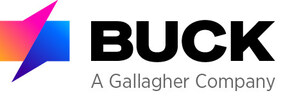NEW YORK, Nov. 15, 2018 /PRNewswire/ -- Buck, an integrated HR and benefits consulting, administration, and technology services firm, today announced new research findings that indicate healthcare costs for employer-sponsored healthcare plans, including premiums for medical and prescription drug coverage, will increase at a slower rate in 2019, but will continue to outpace general inflation.
Buck's Thirty-Seventh National Healthcare Trend Survey analyzes the trend factors that health insurers, large self-funded employers, and third-party administrators use to calculate premium rates, and to project and budget future healthcare costs to employers.
Health care insurers and pharmacy benefits managers report that the rate of increase for prescription drug costs (including price and utilization) are coming down by 1% overall for each group. Based on these indications, employers may expect to see their costs for prescription drugs going up, however they will be going up at a lower rate than was projected six months ago in Buck's 36th Healthcare Trends Survey. Now, according to health insurers, the increase in prescription costs is projected at 10% (vs. 11% six months ago). Employers and plan sponsors could expect to see the medical costs going up by a rate lower than was projected in the last survey as well. However, the decline in the rate of increase is not as pronounced as that for drug costs.
Buck's research indicates the following:
- Medical costs are projected to increase in 2019 at rates that are lower than those in the previous two surveys.
- However, healthcare costs are still expected to increase at rates greater than general inflation.
Buck measured the projected average annual increase in employer-provided health care benefit costs for four types of plans.
Medical Costs
The chart below shows that medical costs are projected to increase in 2019 at rates that are lower than in its prior surveys.
Type of Plan |
Buck's National Health Care Trend |
||||
37th Survey |
36th Survey |
35th Survey |
|||
Preferred Provider Organization (PPO) |
7.5% |
8.1% |
8.2% |
||
Point-of-service (POS) |
7.2% |
7.6% |
7.8% |
||
Health Maintenance Organization (HMO) |
7.7% |
7.7% |
7.8% |
||
High Deductible Consumer Driven |
7.4% |
8.2% |
8.1% |
||
More favorable claim experience and a reduction in provider reimbursement rates were cited by respondents as two key reasons for the projected slowdown in trend increases in 2019.
"Although we're seeing a general slowdown in healthcare cost increases in the coming year, costs continue to rise at a rate higher than general inflation," said Harvey Sobel, FSA, a Buck principal and consulting actuary who directed the survey. "There are a number of factors that continue to drive healthcare cost increases, such as advances in high-cost medical technology, physician practice and hospital system consolidation (which gives larger healthcare organizations greater leverage in bargaining with managed care organizations), and greater usage of diagnostic tests and treatments."
Prescription Drug Costs
Health insurers reported a weighted average prescription drug trend of 10%, which is down by 0.9% from the prior year. The weighted average trend reported by Pharmacy Benefit Managers (PBMs), who generally do not take any underwriting risk, also dropped by a comparable rate of 1.0%, from 6.7% to 5.7%. Survey respondents cited a variety of reasons for the drop, such as reduced pharmacy reimbursement rates, reduced utilization, and reduced specialty drug costs.
About Trend Factors
Health insurers use trend factors to calculate premium rates, and large self-funded employers use trend factors to budget their future health care costs. In general, trend factors provide for price increases that may result from such variables as inflation, utilization of services, technology, and changes in the mix of services. Employers could see premium rate increases that differ from the factors summarized in this report, as the final premium rate increase reflects other factors, such as changes in benefit design and recovery of prior period losses.
Methodology
Buck's Thirty-Seventh National Healthcare Trend Survey is based on responses from 112 insurers and/or administrators who provided input on the set of trend factors which they use to project health care factors. Insurers and administrators providing medical and prescription drug benefits cover over 100 million plan participants, according to the study.
Buck's 37th National Health Care Trend Survey report is published here.
About Buck
Buck is an integrated HR and benefits consulting, administration, and technology services provider. Headquartered in New York City, with global operations, Buck is focused on helping its clients realize the best organizational performance for their business while driving positive health, wealth, and career outcomes for their people. For additional information, visit www.buck.com.
Media contact:
Lumina Communications for Buck
Hollie Smith / Michael Gallo
646-741-8359 / 212-239-8594
[email protected]
SOURCE Buck
Related Links
WANT YOUR COMPANY'S NEWS FEATURED ON PRNEWSWIRE.COM?
Newsrooms &
Influencers
Digital Media
Outlets
Journalists
Opted In





Share this article